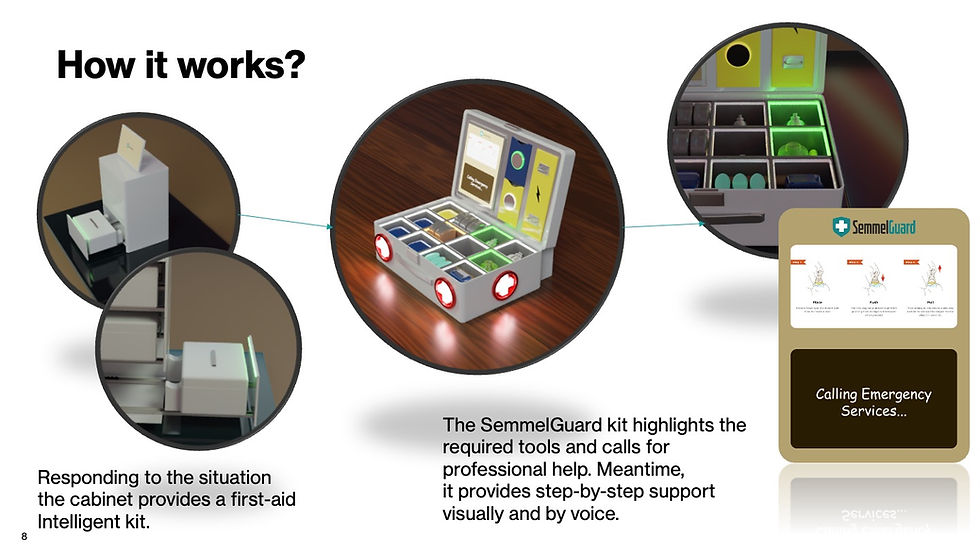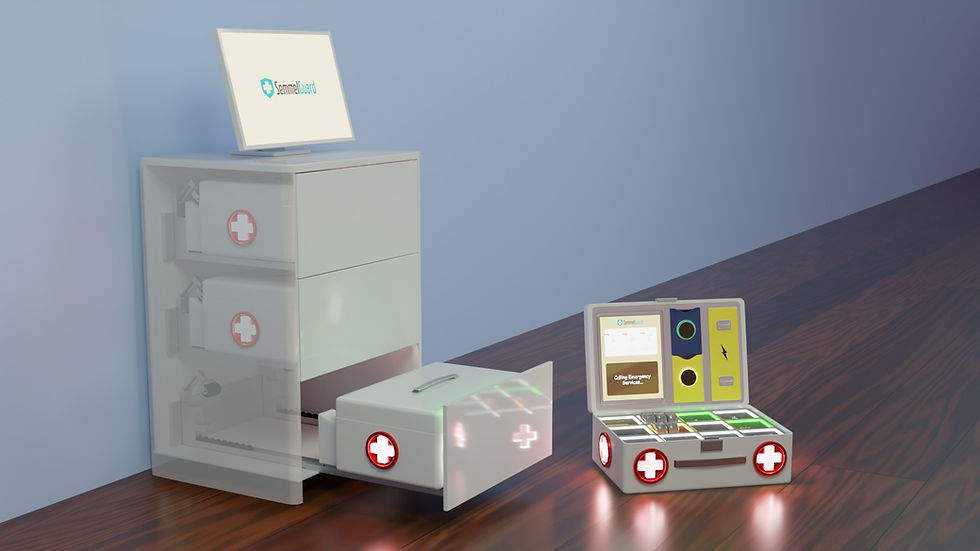
Design Problem
Household incidents such as falls, burns, anaphylaxis, or cardiac arrest claim thousands of lives in Europe each year. According to a study published by the British Red Cross, it is estimated that 43-59% of these deaths could be prevented with timely first aid. Yet only 43-57% of casualties receive help before paramedics arrive. (McNulty, 2016) The primary research highlighted the gap: half of the neighbours and colleagues surveyed could not recall their local emergency number, and home kits were often used up or expired, leaving little more than plasters available.
The kit can function as a single rechargeable first-aid unit. It includes custom-selected tools and medications to meet its owner's potential needs. Alternatively, it can be installed in a cabinet designed to accommodate up to three first-aid kits, each equipped with tools for various scenarios, thus providing complete protection. Each kit features NFC-tagged supplies with a lithium battery-powered AI-capable unit that offers intelligent, step-by-step audio-visual guidance and automated emergency services callouts. The intelligent unit routinely monitors inventory and orders restocks as necessary. Plug-in cartridges (ECG, AED) enable households to tailor their protection to their needs and budget. Optionally, cloud-based services (e.g. automated stock management), live responder coaching, and insurance-linked subsidisation can extend the product into a service and system-level innovation.
Description of the Project


During the early stage of framing the problem, my approach focused on untrained youth. However, interviews with paramedics and carers revealed that confidence is drastically reduced under stress across all ages, significantly widening the target group.
Therefore, I identified three opportunities of a solution that:
-
guides helpers under stress
-
keeps first aid inventory mission-ready
-
integrates seamlessly with the emergency service network
Problem Framing

Initially, the primary concern was the lack of instructions in first aid kits and the bystanders’ lack of confidence in providing first aid support.
However, the scope was widened based on tutor feedback and talking to potential primary stakeholders about the current state of first-aid kits they are familiar with. Clear instructions are sorely needed, but due to the stress experienced by people when they need to act, it became even more critical to minimise the cognitive load on helpers.
Based on tutor feedback constraints, cost and environmental impact were also considered in finding the right solution for the problem.
Process


Using constructive discontent, it was possible to analyse existing products or systems. This exposed flaws in household first-aid kits, including a lack of guidance, poor accessibility for untrained users, and a static and unengaging design.
Brainstorming sessions were a great way to generate ideas, triggering more than twenty initial ideas that were narrowed down to 10 concepts. (Note: originally, SemmelGuard was named SmartAid, but later, I found on online research that this brand already existed and changed it to SemmelGuard)
Building on other ideas was used to review IoT wearables and AEDs. This helped further develop the concepts. Using SWOT analysisSemmelGuard was selected as the winning concept due to its high relevance to stress-proof UX, a modular and clear upgrade path, and the lowest technical risk. However, the Guardian Access and First Response Companion were retained as future service layers, preserving system-level scalability
Problem Framing



My name is Janos Molnar. I began my career aiming to be a software engineer but found greater enjoyment in problem-solving and creating solutions. My studies in Design and Innovation at the Open University enhanced my skills, and I hope to contribute to making the world better through my work.

